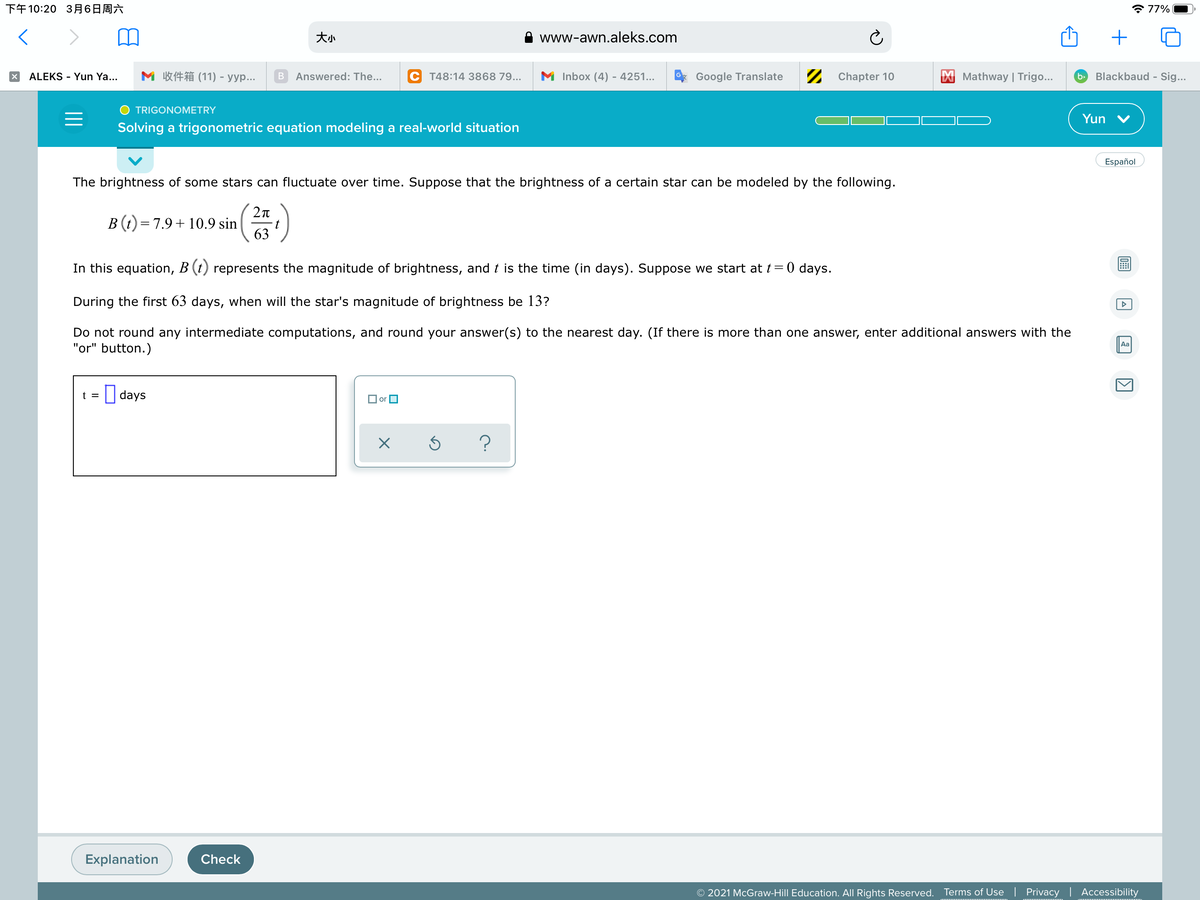The brightness of some stars can fluctuate over time. Suppose that the brightness of a certain star can be modeled by the following. B (t) = 7.9 + 10.9 sin 63 In this equation, B (1) represents the magnitude of brightness, and t is the time (in days). Suppose we start at /= 0 days. During the first 63 days, when will the star's magnitude of brightness be 13?
The brightness of some stars can fluctuate over time. Suppose that the brightness of a certain star can be modeled by the following. B (t) = 7.9 + 10.9 sin 63 In this equation, B (1) represents the magnitude of brightness, and t is the time (in days). Suppose we start at /= 0 days. During the first 63 days, when will the star's magnitude of brightness be 13?
Algebra & Trigonometry with Analytic Geometry
13th Edition
ISBN:9781133382119
Author:Swokowski
Publisher:Swokowski
Chapter10: Sequences, Series, And Probability
Section10.2: Arithmetic Sequences
Problem 67E
Related questions
Question

Transcribed Image Text:下午10:20 3月6日周六
* 77%
大小
www-awn.aleks.com
ALEKS - Yun Ya...
M 收件箱(11) - yyp
Answered: The...
M Inbox (4) - 4251...
2 Chapter 10
Mathway | Trigo...
Blackbaud - Sig...
T48:14 3868 79...
Google Translate
b>
TRIGONOMETRY
Yun
Solving a trigonometric equation modeling a real-world situation
Español
The brightness of some stars can fluctuate over time. Suppose that the brightness of a certain star can be modeled by the following.
B(t) = 7.9+ 10.9 sin
63
In this equation, B (t) represents the magnitude of brightness, and t is the time (in days). Suppose we start at t= 0 days.
During the first 63 days, when will the star's magnitude of brightness be 13?
Do not round any intermediate computations, and round your answer(s) to the nearest day. (If there is more than one answer, enter additional answers with the
"or" button.)
Aa
|| days
t =
O or
Explanation
Check
© 2021 McGraw-Hill Education. All Rights Reserved. Terms of Use | Privacy
Accessibility
Expert Solution
This question has been solved!
Explore an expertly crafted, step-by-step solution for a thorough understanding of key concepts.
This is a popular solution!
Trending now
This is a popular solution!
Step by step
Solved in 2 steps with 2 images

Knowledge Booster
Learn more about
Need a deep-dive on the concept behind this application? Look no further. Learn more about this topic, trigonometry and related others by exploring similar questions and additional content below.Recommended textbooks for you

Algebra & Trigonometry with Analytic Geometry
Algebra
ISBN:
9781133382119
Author:
Swokowski
Publisher:
Cengage

Glencoe Algebra 1, Student Edition, 9780079039897…
Algebra
ISBN:
9780079039897
Author:
Carter
Publisher:
McGraw Hill

Mathematics For Machine Technology
Advanced Math
ISBN:
9781337798310
Author:
Peterson, John.
Publisher:
Cengage Learning,

Algebra & Trigonometry with Analytic Geometry
Algebra
ISBN:
9781133382119
Author:
Swokowski
Publisher:
Cengage

Glencoe Algebra 1, Student Edition, 9780079039897…
Algebra
ISBN:
9780079039897
Author:
Carter
Publisher:
McGraw Hill

Mathematics For Machine Technology
Advanced Math
ISBN:
9781337798310
Author:
Peterson, John.
Publisher:
Cengage Learning,